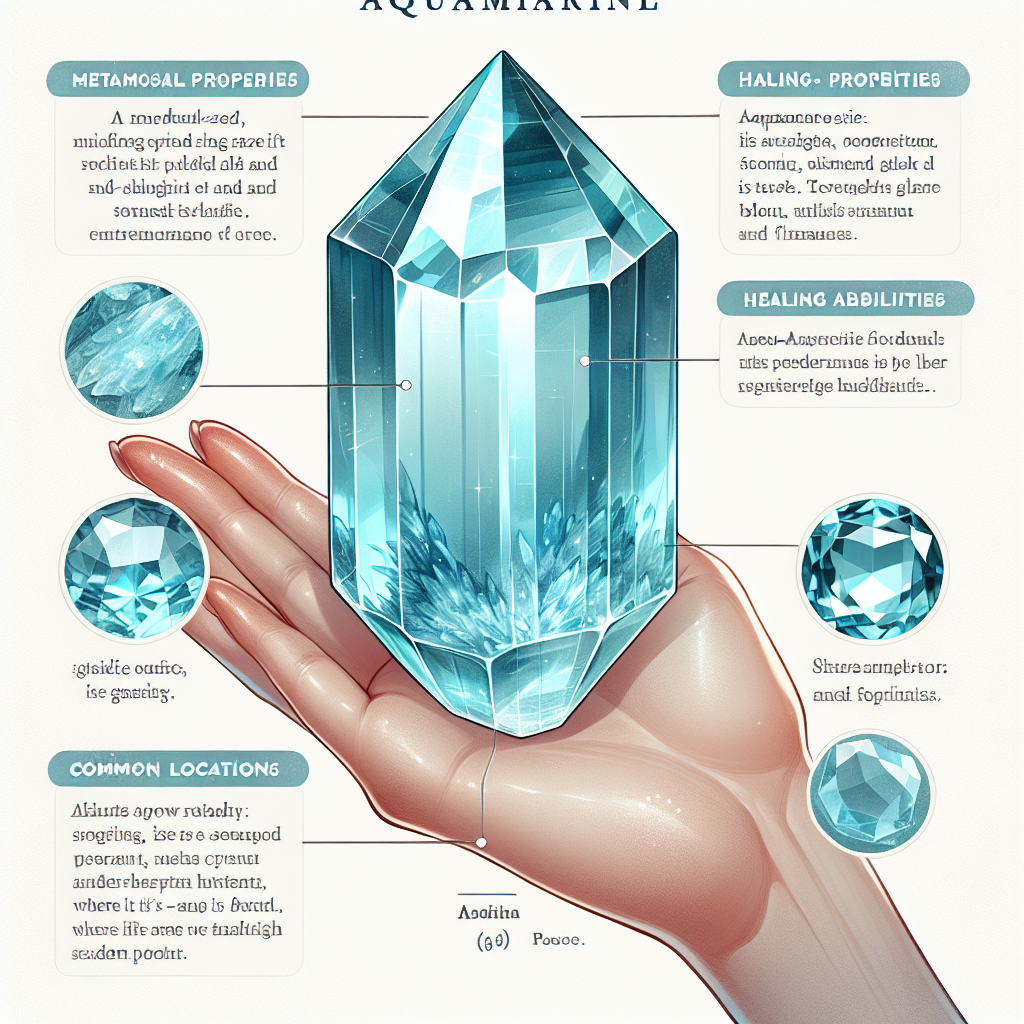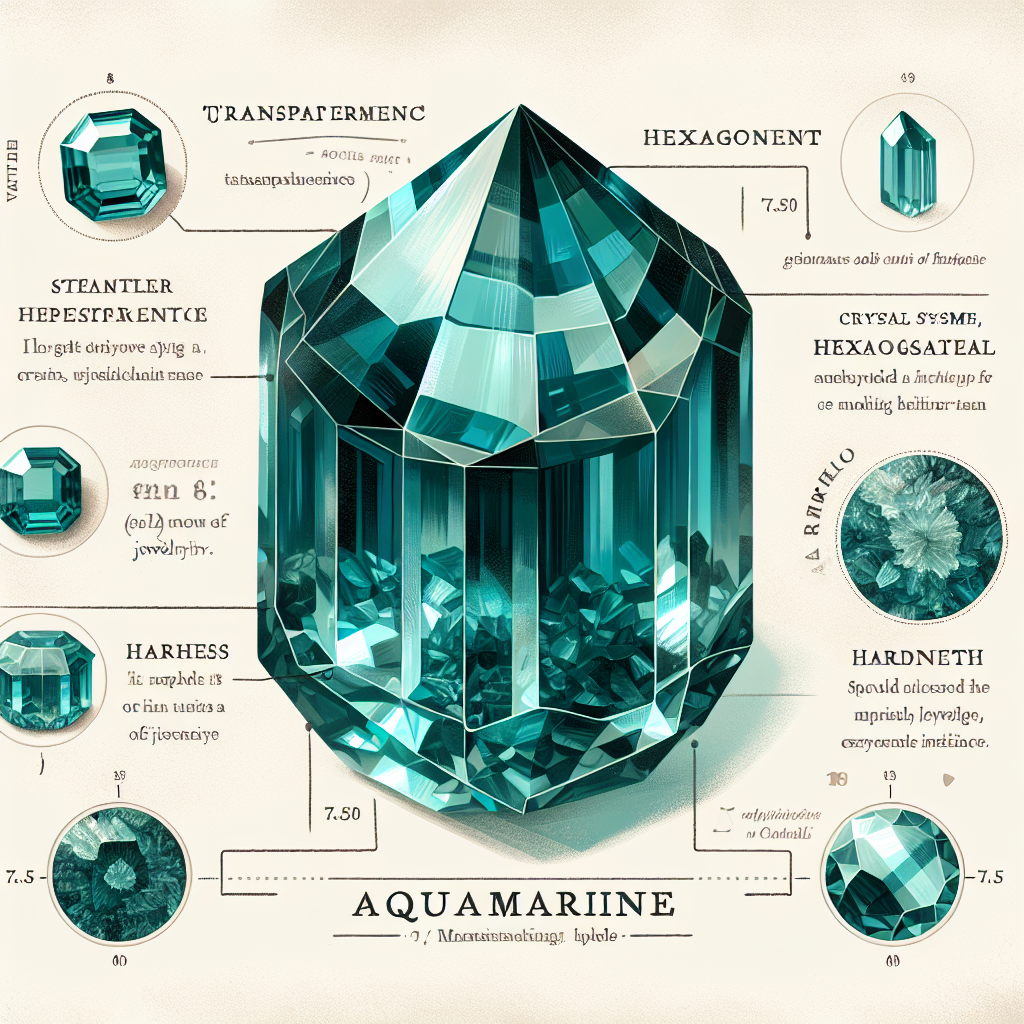As an Amazon Associate I earn from qualifying purchases.
↻
Last updated: December 24, 2025

Aquamarine, a gemstone celebrated for its seawater color and clarity, echoes the essence of the tranquil ocean. The name aquamarine is derived from the Latin words ‘aqua' meaning water and ‘mare' meaning sea, reflecting its soothing blue to blue-green hues. This gem is a member of the beryl mineral family, which also includes other notable gems such as emerald.
Legend has it that aquamarine was first discovered in the treasure chests of mermaids, and since ancient times, it has been revered as a symbol of eternal youth and happiness. Historically, sailors wore aquamarine talismans to protect them from the dangers of the sea and to ensure a safe voyage. It carries connotations of calm and peace, often associated with soothing fears and maintaining a sense of tranquility amidst chaos.
Incorporating aquamarine in everyday life is believed to promote relaxation. Stress reduction is a significant issue facing many individuals today, with the American Psychological Association reporting that more than three-quarters of adults experienced considerable stress in the past month. As a solution, many people turn to meditation, yoga, and the use of healing crystals, like aquamarine, to create a serene environment that facilitates stress relief.
Aquamarine is not only cherished for its beauty but also for its incomparable durability, ranking a solid 7.5 to 8 on the Mohs hardness scale, making it suitable for daily wear. The largest aquamarine ever mined weighed over 110 kg and was found in Brazil, the country that holds some of the most prolific deposits of this captivating stone. Aquamarine's connection to the earth is also of great importance, as it is often used in feng shui practices to create a flow of positive energy in living spaces.
html
What Are the Healing Properties of Aquamarine Crystals?
Aquamarine, a serene blue gemstone, is revered not only for its captivating oceanic hues but also for its purported metaphysical properties. This crystal belongs to the beryl family and gets its name from the Latin ‘aqua marinus', meaning “water of the sea,” reflective of its calming, soothing energy that many users seek for emotional healing. Aquamarine is believed to resonate with the throat chakra, promoting clear communication and alleviating fears of speaking. In addition to its spiritual and emotional benefits, aquamarine is associated with good health, reducing stress, and harmonizing surroundings. For those interested in exploring the extensive benefits of aquamarine, continue reading as we delve deeper into this crystal's fascinating world, uncovering the myriad ways it can enhance your well-being and spiritual journey.
Aquamarine Crystal Guide
Aquamarine, from the Latin “aqua marinus” meaning “water of the sea,” is a blue to blue-green variety of the mineral beryl. It is well known for its stunning transparency and vitreous luster, making it a favorite among gemstone enthusiasts and jewelry designers alike. The presence of iron within its crystal structure is responsible for aquamarine's distinctive color, which can range from a light pastel to a rich, vibrant ocean blue.
Mining and Origin of Aquamarine
The primary sources of aquamarine are found in countries like Brazil, which is home to some of the largest and most prolific aquamarine mines in the world. Other notable locations include the mountains of Pakistan and Russia, as well as parts of Africa, especially in Madagascar, Mozambique, Nigeria, and Zambia. Depending on the geographical location, the shade and quality of the aquamarines can vary significantly.
Healing Properties and Uses
Aquamarine has been attributed with numerous healing properties over the centuries. It is often referred to as the stone of courage, with a calming energy that is said to reduce stress and quiet the mind. In crystal healing circles, aquamarine is utilized to soothe fears, inspire truth, trust, and letting go. It is also traditionally believed to be particularly powerful for sensitive people and those overwhelmed by responsibilities.
Jewelry and Care
Due to its impressive clarity and color, aquamarine is a popular choice for jewelry, particularly as the birthstone for March. It is commonly fashioned into rings, necklaces, earrings, and pendants. Aquamarine crystal rates between 7.5 and 8 on the Mohs scale of hardness, making it relatively durable for everyday wear, though care should be taken to protect it from scratching and sharp blows. It should also be shielded from prolonged exposure to heat and sunlight, which can fade its color.
Value and Quality
The value of aquamarine is typically determined by its color, with more intense blue stones generally being more valuable. Clarity also plays a significant role, as the gem is prized for its transparency. Cut and carat weight further influence the price, with larger, well-cut gems fetching higher prices on the market.
Innovations in Synthetic and Treated Aquamarine
Advancements in gemstone technology have led to the creation of synthetic aquamarines and treatments to enhance natural stones' color and clarity. Heat treatment is a common practice to remove greenish tones and strengthen the desirable blue hue. When purchasing aquamarine, it is essential to inquire whether the stone is natural, synthetic, or has undergone any treatments, as this can significantly affect its value.
Sustainability and Ethical Considerations
The mining of aquamarine, similar to other gemstones, raises concerns about environmental impact and ethical practices. Efforts are being made in some areas to ensure responsible mining that minimizes environmental damage and promotes fair labor standards. Consumers increasingly seek ethically sourced aquamarines, a trend that encourages industry-wide transparency and responsibility.
Continuing Research and Fascination
Aquamarine continues to fascinate gemologists and collectors, with ongoing research into its properties and the development of new sources. As appreciation for this gemstone deepens, so does the understanding of its formation and variations across different locations.
Aquamarine as an Investment
While typically not as high-priced as stones like diamonds or sapphires, fine quality aquamarines do retain value and can be considered as an investment. High-end specimens, especially those with exceptional blue color, size, and clarity, can command impressive prices in the marketplace.
In the world of gemstones, aquamarine remains a beloved stone, with recent statistics from the Gemological Institute of America showing that high-quality blue aquamarines above 5 carats can sell for more than $1,000 per carat. This reflects the stone's enduring value and appeal to both collectors and those simply seeking a piece of the sea's serenity to wear or hold.
1. What is an aquamarine crystal and where does it come from?
Aquamarine is a blue to blue-green variety of the mineral beryl, which also includes gems like emerald. It is mainly found in pegmatites and is typically sourced from countries like Brazil, Madagascar, Russia, Pakistan, and the United States.
2. How can I tell if my aquamarine crystal is real?
To determine if an aquamarine crystal is real, check for consistent coloring, natural inclusions, and cold touch. Aquamarine should be transparent to translucent with good clarity, and genuine stones often have a glassy luster. A professional gemologist can provide a definitive verification.
3. What are the healing properties associated with aquamarine crystals?
Aquamarine is believed to have calming and soothing energies that can help reduce stress and quiet the mind. It is also associated with courage, clear communication, and is said to be beneficial for the throat chakra.
4. How should I clean and care for my aquamarine crystal?
Aquamarine can be cleaned using warm soapy water and a soft brush. Avoid exposing it to harsh chemicals, and store it separately from other gemstones to prevent scratching. Regular cleaning will maintain its sparkle and clarity.
5. Can aquamarine crystals be charged or energized?
Yes, aquamarine crystals can be charged or energized by placing them in sunlight or moonlight for several hours. Some people also like to use methods such as burying the crystal in salt or earth, or cleansing with smoke from sage or palo santo.
6. What are the astrological connections of aquamarine?
Aquamarine is traditionally associated with the zodiac sign of Pisces. It is also considered a birthstone for March and is often connected to the energy of the ocean, aligning with the introspective and fluid nature of Pisceans.
7. Does the size of an aquamarine crystal affect its properties?
The size of an aquamarine crystal does not generally affect its healing properties; however, larger crystals are often used for meditation or energy work as they can be easier to handle and focus on.
8. Are there different types of aquamarine crystals?
While all aquamarine belongs to the same mineral family, there are variations in color and clarity. The deep blue stones, often called “Santa Maria” aquamarines, are the most prized due to their rarity and intense color.
9. What should I consider when purchasing an aquamarine crystal?
When purchasing an aquamarine crystal, consider the color, clarity, cut, and carat weight (the four Cs), as these factors will determine the stone's value. Also, consider whether you prefer a natural, untreated stone or are open to gemstones that have been treated to enhance color or clarity.
10. Can aquamarine be worn every day?
Yes, aquamarine can be worn every day as it registers 7.5 to 8 on the Mohs scale of hardness, making it relatively durable. However, it’s still important to be mindful of potential impacts or scratches and to remove aquamarine jewelry before engaging in rigorous activities.

Conclusion
Aquamarine crystal, known for its captivating sea-blue hue, holds significant importance both aesthetically and metaphysically. As the key points highlighted, this gemstone is synonymous with tranquility, clarity, and protection, attributes tied to its connection to the soothing element of water. Often utilized in jewelry, aquamarine’s durability stemming from its Mohs hardness score makes it suitable for daily wear while its delicate color complements a variety of styles. Metaphysically, aquamarine is revered for its ability to inspire truthful communication and release emotional baggage, an attribute that aligns it with the throat chakra, enhancing the wearer’s ability to articulate their innermost thoughts and feelings with confidence and clarity.
From a historical and cultural standpoint, the lore surrounding aquamarine is as rich as its appearance—reputedly treasured by mermaids, valued by ancient seafarers as a talisman for good luck and protection against storms, and associated with the Greek and Roman gods of the sea. Its significance extends into contemporary times, acknowledged as the birthstone for March and often selected for milestone gifting, epitomizing fidelity and eternal love. Aquamarine crystal's versatility and profound symbolism render it a gemstone that transcends mere ornamentation, forging a tangible connection to ancient wisdom, emotional depth, and the mysticism of the waters it is so evocative of.
Amazon and the Amazon logo are trademarks of Amazon.com, Inc, or its affiliates.
Continue Your Magical Journey
Free Witchcraft Starter Kit
Get 6 free printable PDFs: grimoire pages, moon calendar, spells, crystals, herbs, and tarot journal.
We respect your privacy. Unsubscribe anytime.
Enhance Your Practice
As an Amazon Associate, I earn from qualifying purchases.

